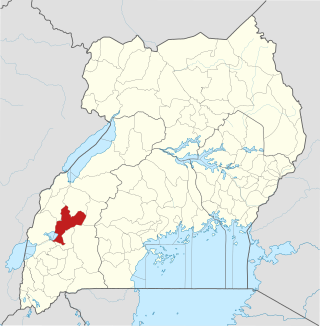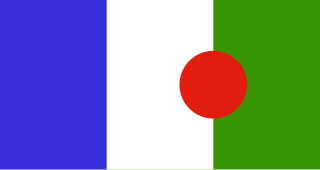The Tutsi, also called Watusi, Watutsi or Abatutsi, are an ethnic group of the African Great Lakes region. They are a Bantu-speaking ethnic group and the second largest of three main ethnic groups in Rwanda and Burundi.

The Abagusii are a Bantu ethnic group indigenous to Kisii and Nyamira counties of former Nyanza, as well as parts of Kericho and Bomet counties of the former Rift Valley province of Kenya.

Kamwenge District is a district in Western Uganda. It is named after its 'chief town', Kamwenge, where the district headquarters are located. Kamwenge District is part of the Kingdom of Toro, one of the ancient traditional monarchies in Uganda. The kingdom is coterminous with Toro sub-region. The districts that constitute the sub-region are: (a) Bunyangabu District (b) Kabarole District (c) Kamwenge District (d) Kyegegwa District (e) Kitagwenda District and (f) Kyenjojo District.

Kigezi District once covered what are now Kabale District, Kanungu District, Kisoro District and Rukungiri District, in southwest Uganda. Its terraced fields are what gives this part of Uganda its distinctive character. Kigezi was popularly known as the Switzerland of Africa. The coordinates for the region are: Latitude:01 13 20S, 29 53 20E.
The Hororo or Bahororo are a Bantu-speaking ethnicity mainly residing in the north of the former Kigezi District in southwestern Uganda. In 1905, they were described by a British officer as a "quiet, inoffensive people" who owned cattle. They are made up mostly of the Hima ethnic group and the Bantu ethnic group. They reside mainly in Rujumbura in southwestern Uganda and are related to the Banyankole, Banyoro, Batooro, Songora and Tutsi peoples respectively. Rujumbura was ruled by the BeeneKirenzi sub-clan with Omukama Karegyesa as their last king. The Bahororo speak a dialect of Nkore-Kiga, Ruhororo. They are subdivided into clans that are similar to those of the kingdom of Ankole. Unlike Ankole, which was ruled by the Hinda clan, Mpororo was led by the Bashambo clan.
Imana is the creator deity in the traditional Banyarwanda and Barundi religion in Rwanda and Burundi and other related ethnic groups, such as Baha in Tanzania and Banyamulenge in the Democratic Republic of Congo. In current-day usage, the term refers to God as found in Christianity. Ancient Banyarwanda and Barundi believed in one god, the creator Imana. In their mythology, Imana was the creator and the supporter of all the Barundi and Banyarwanda people. Imana was seen as almighty and gracious, intervening in one of the legends in an altercation between a man who had always borrowed beans from different people but wriggled out of repaying the debt.

The Ha, also called Abaha, are a Bantu ethnic group found in Kigoma Region in northwestern Tanzania bordering Lake Tanganyika. In 2001, the Ha population was estimated to number between 1 and 1.5 million, making them one of the largest ethnic groups in ethnically diverse Tanzania.
The Banyarwanda are a Bantu ethnolinguistic supraethnicity. The Banyarwanda are also minorities in neighboring DR Congo, Uganda and Tanzania.

The Konjo, BaKonzo, or Konzo, are a Bantu ethnic group located in the Rwenzori region of Southwest Uganda in districts that include; Kasese, Bundibugyo, Bunyangabu and Ntoroko districts.

The cuisine of Rwanda is based on local staple foods produced by the traditional subsistence-level agriculture and has historically varied across different areas.
Rwanda-Rundi is a group of Bantu languages, specifically a dialect continuum, spoken in Central Africa. Two dialects, Kirundi and Kinyarwanda, have been standardized as the national languages of Burundi and Rwanda respectively. These neighbouring dialects are mutually intelligible, but other dialects which are more distant ones may not be. The other dialects are spoken in the Democratic Republic of the Congo, Uganda, and Tanzania; Ha, with one million speakers, is the most widely spoken.
Katuna is a town in the Kabale District of Uganda at the border with Rwanda. The town is also called "Gatuna" in the Kinyarwanda language.

The Twa, often referred to as Batwa or Mutwa (singular), are indigenous hunter-gatherer peoples of the Great Lakes Region in Central Africa, recognized as some of the earliest inhabitants of the area. Historically and academically, the term “Pygmy” has been used to describe these groups, however, it is considered derogatory, particularly by the Twa themselves. While some Batwa activists accept the term as an acknowledgement of their indigenous status, most prefer specific ethnic labels such as Bambuti, Baaka, and Bambendjelle.

The Great Lakes Twa, also known as Batwa, Abatwa or Ge-Sera, are a Bantu speaking group native to the African Great Lakes region on the border of Central and East Africa. As an indigenous pygmy people, the Twa are generally assumed to be the oldest surviving population of the Great Lakes region. Current populations of Great Lakes Twa people live in the states of Rwanda, Burundi, Uganda and the eastern portion of the Democratic Republic of Congo. In 2000 they numbered approximately 80,000 people, making them a significant minority group in these countries. The largest population of Twa is located in Burundi estimated in 2008 at 78,071 people.

The Fuliru people are a Bantu ethnic group native to the South Kivu Province of the eastern region of the Democratic Republic of the Congo. They predominantly inhabit the Uvira Territory, forming the largest ethnic group within the Bafuliiru Chiefdom, located centrally and to the northwest. They also form the primary constituency in the Ruzizi Plain Chiefdom, to the northeast, near the Rwanda and Burundi borders, where some Fuliru communities reside.
Nyamanga is the community found in Kyenjojo District. It is one of the nine parishes and a village in Bufunjo Sub-county. Kyenjojo District is found in Mid - Western Uganda and in Toro Kingdom which is one of the known kingdoms in Uganda. The other kingdoms are Buganda, Bunyoro and Busoga. In this community there are a number of tribes living together with majority being the Batooro but other tribes such as Bakiga, Banyankore and Bafumbira started coming to this community as early as the 1980s and since then have become bona fide members of this community. The major language spoken is Rutooro for the Batooro and most of the other tribes speak it. Others include Runyankore-Rukiga and Rufumbira for the rest of the tribes. Almost everyone in this community understands Rutooro since it is the main language used.
The Baruuli or Baluuli, are a Bantu ethnic group native to Bunyoro-Kitara, a subnational kingdom within Uganda. They stay in an area called Buruuli. They share a common ancestry with the Banyala.

Banyala, are a Bantu ethnic group native to Buganda, a subnational kingdom within Uganda. They stay in an area called Bugerere in Kayunga District,. They share a common ancestry with the Baruuli.

Rubanda District is a district in the Western Region of Uganda. The largest town in the district, Rubanda, serves as the main administrative and commercial center in the district.
Ebyevugo is a genre of oral poetry in the Runyankore language, spoken by the Banyankore people of southwestern Uganda. Ebyevugo are mainly composed and performed to praise cattle, brides, warriors, and political leaders. They reflect the traditional pre-colonial occupations, values, and history of the Banyankore, especially the Bahima, who are cattle keepers.













